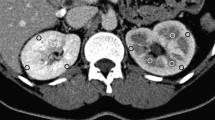Abstract.
Unenhanced helical computerized tomography (UHCT) has recently evolved as an accurate imaging modality for determination of the presence or absence of ureterolithiasis in patients with acute flank pain. Functional renal scintigraphy is considered the gold standard for urinary tract obstruction. The objective of this study was to correlate the secondary signs of urinary obstruction on UHCT with findings of functional renal scintigraphy. UHCT was performed in 30 patients admitted to the emergency room with acute flank pain. All patients had a calcified urinary stone identified on UHCT. The location of each urinary stone was classified as ureteral or in the ureterovesical junction. The presence of secondary CT signs of ureteral obstruction was determined for each patient. After oral or intravenous hydration, a technetium-99m diethylene triamine penta-acetic acid renal scan was performed in all patients within 12 h of the CT scan. Follow-up delayed scintigraphic images were obtained at 2 h and 24 h in patients with evidence of ureteral obstruction. The sensitivity, specificity and predictive values of each possible combination of CT findings were determined by comparison with the scintigraphic results. The distal ureter was the most common location for a calculus on UHCT, followed in frequency by the ureterovesical junction, proximal ureter and mid-ureter. The renograms showed high-grade, unilateral obstruction in 12 patients, indeterminate scans in five patients and normal renograms in 13 patients. The sensitivities and specificities of individual CT findings ranged from 50% to 75% and from 8% to 69%, respectively. Perinephric stranding gave the highest positive predictive value (PPV) for obstruction (69% including indeterminate renograms). None of the individual CT findings showed a statistically significant correlation with scintigraphic findings. A combination of one or two positive CT findings had a PPV of only 25% for obstruction. A combination of three or four positive CT findings gave a PPV of 70% for obstruction. Our preliminary study shows that secondary CT signs of ureterolithiasis correlate poorly with the scintigraphic findings and that they do not permit evaluation of the functional status of obstructed kidneys. Even a combination of the most frequent CT findings has a low predictive value, i.e. does not allow a decision to be made as to the most suitable treatment. Therefore, renal scintigraphy should be performed in conjunction with UHCT in all patients with ureteral calculi.
Similar content being viewed by others
Author information
Authors and Affiliations
Additional information
Received 21 October and in revised form 14 December 1999
Rights and permissions
About this article
Cite this article
Lorberboym, M., Kapustin, Z., Elias, S. et al. The role of renal scintigraphy and unenhanced helical computerized tomography in patients with ureterolithiasis. Eur J Nucl Med 27, 441–446 (2000). https://doi.org/10.1007/s002590050528
Issue Date:
DOI: https://doi.org/10.1007/s002590050528




